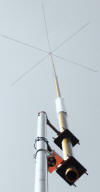| RadioSAFE Systems to Assist Community Safety in Bigger Way | |||
A new radio antenna system is making waves in the public safety realm that are being felt from coast to coast. The HPR.0990 Antenna is at the heart of a novel system called “RadioSAFE,” which can function for communities impacted by wildfire, hurricane, or flooding in ways that social media-based notification systems cannot. That is because when calamities strike, notification systems based on wireless communications take a punch to the gut when power is lost. In places where cell towers do have generator backup, the run-time is limited by tank size and the ability get new fuel to the tower site. And, of course, the amount of information that text-based notification systems can push out is limited to a few sentences. Those who do receive the alerts are required to have signed up for them in advance, and statistically, most people don’t. The new HPR.0990 Antenna makes the RadioSAFE solution unique because of its enhanced efficiency combined with its ability to handle 10 times the power of its predecessors. With a special FCC license, the antenna gives RadioSAFE systems the ability to take coverage that did not go beyond the city-level, out to the county-level. The system is available in three configurations, the largest of which sports a broadcast radius of more than 20 miles. The HPR.0990 Antenna is a relatively small and light, given its impressive capabilities. The whip antenna is just 32 feet long fully assembled, and weighs in at only 30 pounds. It can be mounted on a simple 20’ pole or tower located in the yard of a public safety center. Erected, its height above ground can be less than 50 feet, allowing it to duck under many local zoning ceilings. It is manufactured by long-time antenna partner Morad Antenna Company specifically for Information Station Specialists, the sole distributor. RadioSAFE systems, which include the HPR.0990 Antenna wrap in all the required electronics, engineering and installation services to make this community safety solution complete. It can be licensed in most areas of the USA, however, frequency space is limited. Learn more about RadioSAFE systems here. Contact Information Station Specialists via email here. |
| ||
| |||
PO Box 51, Zeeland, Michigan, USA, 49464-0051, Phone 616.772.2300, Email
• • •

